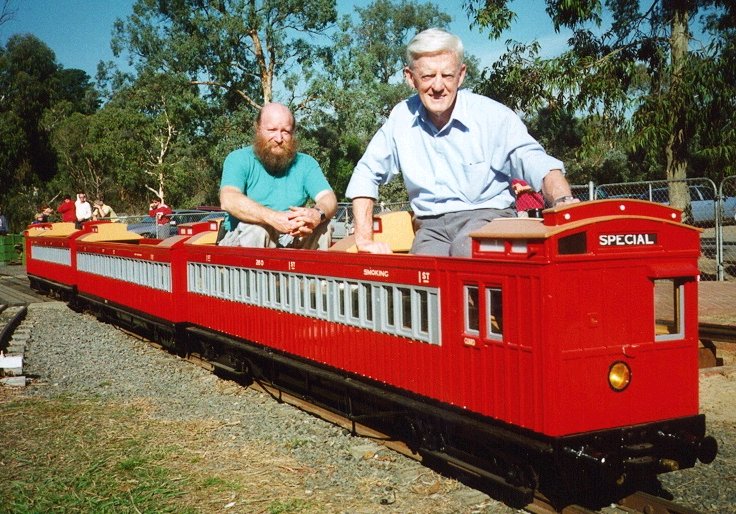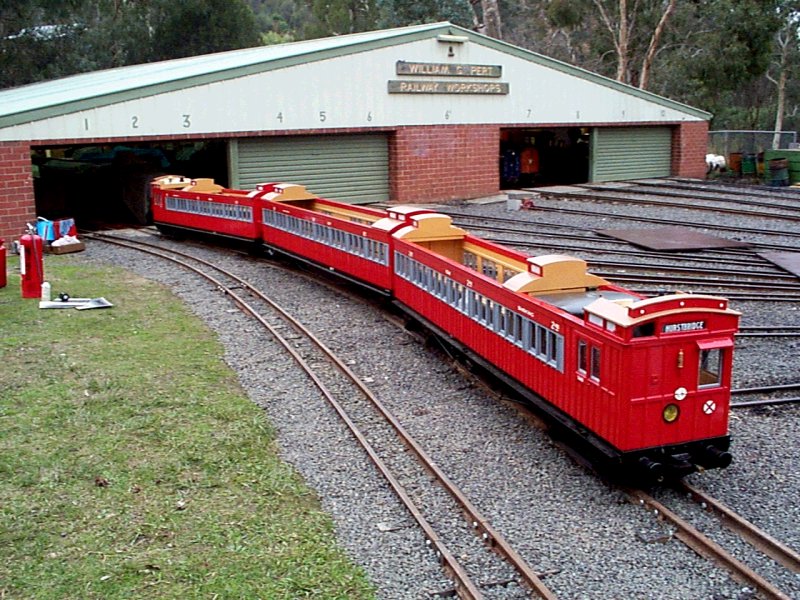
THE DOGGIES - BY A. FOOT
Our trusty 3-car electric suburban trainset, the "Doggies", have just had a birthday. They recieved a new "coat", some bearings, plus a lot of little repairs to make them feel young again. 1997/1999 will see these cars celebrate their 20th anniversary so it is timely that they come in for a pre-anniversary treat! I thought it would be interesting to find out something about their life and history at the DVR, both for myself and for many of our younger members.
The train was built by G. George who was a DVR member during the 1970's & 1980's. Two motor cars 8ACM & 10ACM were constructed in 1977 & 1979 respectively. Both cars were built as 12 volt single motor cars with a tapped resistance control system on each motor, fitted with air brakes. One bogie in each car was powered. The cars could be controlled together using a 28way train control cable running through both cars. However although the cars could operate as a multiple unit, capable of running in both directions, only 10ACM was fitted with a complete drivers panel. 8ACM could be driven from very basic controls only.
During 1978 J. Willcox was completing his W country cars. G. George and J. Willcox helped each other in the construction of both trainsets with additional help from other DVR members. 8ACM was finished first and for a while it ran behind Jim's E class electric loco with a W car. This created an interesting visual combination at the time when members were developing examples of "real" rolling stock as opposed to , say the "coffin" cars which provided the bulk of our passenger carrying vehicles at the time.
In 1978 8ACM then began operation as a 2-car train when trailer car 9ADAD arrived on the scene that year. The third car, 10ACM completed the 3-car set in 1979 and the train ran in this form until 1984, when G. George sold it to DVR member J. McCallum.
At this time brakes were controlled only from the drivers position in 10ACM, this car being the only one with complete driving controls. 8ACM was provided with a very elementary system of electrical and braking control which in the long run proved unsatisfactory in service. John modified the braking to allow better operation from the rear of the train. John also installed larger capacity batteries to improve performance and battery life but this problem was never completely solved until the present set of batteries were installed around 1992.
The motor bogies also had problems particularly brushgear on the North East Motors. They were modified for 4 brush operation to reduce arcing and new axle bearings were installed. Alterations to axle boxes and some repositioning inside the bogie frames were also part of the improvements after broken axles were suffered in service.
The motor bogie in 8 ACM was disconnected with the intention of installing it in 10 ACM to make it a 2-motor car but this was not carried out at this time. Ongoing problems with the bogies resulted in cars being out of service for long periods due to a shortage of serviceable bogies. The E class loco assisted frequently to provide substitute power for the remaining cars.
J. McCallum ran the train with varying degrees of reliability until 1989, when he offered it for sale to the DVR on an "AS IS" basis. After being purchased by the railway the train spent much time in the Rolling Stock workshops where a lot of work was done on the undergear as much as was possible at the time. The train then gave reasonable service over the next couple of years while still beset with many problems.
In 1991 I joined the railway, at this time the Doggies were in a sad state with cars out of service for long periods and the electrical system unreliable.
It was about this time that the Rolling Stock branch decided that 10ACM would now be converted to a 2-motor-bogie car & 8ACM would be unpowered such as J. McCallum had envisioned some years earlier. The system would be upgraded to 24 volts using heavy duty deep cycle traction batteries and a 4-notch controller installed to give series and parallel functions with the traction motors. This would also be closer in operation to the real thing. Two 12 volt traction batteries were installed, their size dictating that one would be in 10ACM and the other in 8 ACM, with battery cables installed throughout the 3 cars. I became interested in constructing the electrical system required to operate under these conditions.
In 1992 I installed a relay panel behind the drivers seat in 10ACM and this carried all of the relays needed to operate the two motors as well as the main circuit breaker, 12/24 volt auxiliary supplies, and connections to a new 25way control cable running the length of the car. A new drivers panel containing all operating switches, meters etc. was installed and connected to this cable at the van end. This was the first step towards arranging for a new drivers panel to go into 8ACM in the future via the new train control cable.
A matching panel carrying the air brake controls & gauges was also installed alongside the electrical panel. The train now had a realistic control position with 4 speed notching control in the left hand and air brake handle on the right.
At the same time the Rolling Stock branch carried out extensive work on bogies, brakes and air system to eventually get all 3 cars back into service by early 1993, due mainly to S. Coombs and M. Murdoch. After some initial problems with relay failure due to welded contacts etc. - it was necessary that a better type of contactor capable of switching heavy motor currents when notching up and down was needed. A. Mierisch located a suitable heavy duty unit, three were purchased to perform the series/parallel switching functions under the control of the relays in the drivers panel. These have proved to be completely reliable with no problems experienced since their installation.
The train control cable was extended through all 3 cars at this time to a point in 8ACM's van ready for this car's driving panel. However almost two years were to pass before this took place during which time the train performed very well, there being no serious problems arising.
In 1996 8ACM finally received its driving panels which were laid out exactly as those in 10ACM and finally allowing the train to be driven in each direction with ease. Isolating cocks were also installed at each driving position for the brakes. A working destination blind was installed in 8ACM during the body modifications required to fit the drivers panel. Details changes were made to the head/tail and marker lights to switch automatically following the forward/reverse field switching functions.
Finally, during Jan-April 1997 each car was transported to the North Blackburn Paintshops (thank you C. Eastes ) and completely repainted in the 1936 livery of red and grey with black lining. The cars were accordingly renumbered & signage replaced to become:
- 10M (2nd class motor ex 10ACM)
- 19T (1st class trailer ex 9ADAD)
- 28D (1st class driving trailer ex 8ACM)
A destination blind was also installed and marker lights modified to switch with the field reversing switch as 10ACM passed through the paint shops. Upholstering of the seats in the 3 cars is in progress and will complete their refurbishment.
Over the years the Doggies have taken part in some memorable events. In 1985 When Pine Tree Loop was commissioned, local MP for Eltham , the late Pauline Toner, patron of DVR at the time and a dedicated enthusiast drove the Doggies over the loop as the first train.
Later in 1995 DVR member M. and L. Wallis on being married a the railway were transported with the wedding party to their reception, held opposite Diamond Valley Station. The train was suitably decorated with bunting on each occasion.
Each Christmas season the doggies are often used for "Santa Specials" as well when our picnic facilities are being used by Social Clubs etc for their breakup parties.
The Doggies are now performing at their best and should give many years of faithful service. I am sure that Gary would be more than pleased to see them running so well. I would like to thank G. George and J. McCallum for their assistance in providing information for this article.


